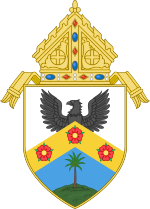Archdiocese of Jaro Archdiocesis Jarensis
| |
|---|---|
| Catholic | |
 | |
 Coat of arms | |
| Location | |
| Country | |
| Territory | |
| Ecclesiastical province | Jaro |
| Headquarters | Jaro, Iloilo City |
| Coordinates | 10°43′24″N 122°33′22″E / 10.7234°N 122.556°E |
| Statistics | |
| Area | 5,303 km2 (2,047 sq mi) |
| Population - Total - Catholics | (as of 2021) 3,668,000 3,049,000[1] (83.1%) |
| Parishes | 95 |
| Information | |
| Denomination | Catholic |
| Sui iuris church | Latin Church |
| Rite | Roman Rite |
| Established | May 27, 1865 (Diocese) June 29, 1951 (Archdiocese) |
| Cathedral | Metropolitan Cathedral of St. Elizabeth of Hungary |
| Patron saint |
|
| Secular priests | 166 |
| Current leadership | |
| Pope | Francis |
| Metropolitan Archbishop | Jose Romeo Lazo |
| Suffragans |
|
| Map | |
 Jurisdiction of the metropolitan see within the Philippines. | |
| Website | |
| Archdiocese of Jaro | |
The Archdiocese of Jaro (Latin: Archdiocesis Jarensis; Hiligaynon: Arkidiyosesis sang Jaro; Filipino: Arkidiyosesis ng Jaro; Spanish: Arquidiócesis de Jaro) is a Latin Church archdiocese of the Catholic Church headquartered in Jaro, Iloilo City, Philippines. Its episcopal see is at the Metropolitan Cathedral of St. Elizabeth of Hungary, also the National Shrine of Our Lady of Candles, as its seat.[2] The metropolitan archdiocese covers the provinces of Iloilo, Guimaras, Antique, and Negros Occidental. Its titular patron saint is Elizabeth of Hungary, whose feast is celebrated on November 17.[2]
The Archdiocese of Jaro is one of the oldest episcopal sees in the country. It was established on May 27, 1865, through a papal bull of Pope Pius IX,[3] according to a document signed by Archbishop Gregorio Martinez, then archbishop of Manila. The diocese was created from the territory of the Archdiocese of Manila. Its first bishop was Mariano Cuartero, a Dominican missionary in the Philippines, who took possession of the diocese, on April 25, 1868.[3] It is also one of the largest episcopal sees during the Spanish colonial era encompassing the whole island of Panay (Aklan, Antique, Capiz, Guimaras and Iloilo provinces), Mindoro, Romblon, Negros (Negros Occidental and Negros Oriental provinces), Palawan, Davao, Sulu, Cotabato and Zamboanga Peninsula as part of its jurisdiction.
On April 10, 1910, it lost some of its territories to the newly created Diocese of Zamboanga and Apostolic Prefecture of Palawan. Negros Oriental (Dumaguete) was also a part of it, but became a separate diocese under Cebu. Later, three other ecclesiastical jurisdictions were established from its territory: the Diocese of Bacolod (July 15, 1932), Apostolic Prefecture of Mindoro (July 2, 1936), and the Diocese of Capiz (January 27, 1951).[2]
On April 28, 1934, Pope Pius XI promulgated apostolic constitution Romanorum Pontificum semper separating the dioceses of Cebu, Calbayog, Jaro, Bacolod, Zamboanga and Cagayan de Oro from the ecclesiastical province of Manila. The same constitution elevated the diocese of Cebu into an archdiocese while placing all the newly separated dioceses under a new ecclesiastical province with Cebu as the new metropolitan see.[4] On June 29, 1951, it was raised as a metropolitan archdiocese by Pope Pius XII.[3] On March 24, 1962, it lost some territory to establish the Territorial Prelature of San Jose de Antique, which was later elevated as a diocese in 1982.[2]
The ecclesiastical province of Jaro consists of the metropolitan archdiocese of the same name, as well as its suffragan dioceses of Bacolod, San Carlos, and Kabankalan, all in the province of Negros Occidental, and San Jose de Antique in the province of Antique.[2]
- ^ "Jaro (Catholic Metropolitan Archdiocese)". gcatholic.org. Retrieved September 16, 2023.
- ^ a b c d e "Archdiocese of Jaro". GCatholic.org. Retrieved August 10, 2018.
- ^ a b c "Archdiocese of Jaro". Claretian Communications Foundation. Retrieved August 10, 2018.
- ^ Pope Pius XI (April 28, 1934). "Apostolic Constitution separating some dioceses from the ecclesiastical province of Manila to form the new ecclesiastical province of Cebu" (PDF). pp. 263–264.